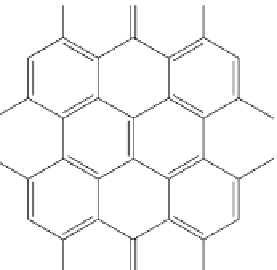Geoscience Reference
In-Depth Information
Quinones
Quinones are a large class of compounds endowed with a
rich and fascinating chemistry (Patai and Rappaport, 1988).
1,4-Benzoquinone or
p
-benzoquinone is the basic structure of
quinonoid compounds. The natural quinone pigments range in
colour from pale yellow to almost black and there are over 450
known structures (Harborne, 1973). These compounds are also
responsible for the browning reaction in cut or damaged fruits
and vegetables, and are an intermediate in the melanin synthe-
sis pathway in human skin. Hypercin (
10
), an anthroquinone
which is an example of quinine obtained from St. John's wort
(
Hypericum perforatum
), has received much attention as an
antidepressant and an antiviral. It also has several antimicrobial
properties (Aarts, 1998).
OH
O
OH
HO
HO
OH
O
10
OH
essential oils
Essential oils are generally a complex mixture of terpenoids
(terpenes and their oxygenated derivatives). However, other com-
pounds, namely, phenyl propanoids, fatty acids, and their ester,
aliphatics, and phenolics also occur in essential oils. Essential
oils are the main compounds found in the volatile steam distil-
lation fraction responsible for the characteristic scent, odour or
smell found in many plants. Some essential oils possess medicat-
ing properties and are used in the pharmaceutical industry. They
are commercially important as the basis of natural perfumes
and also of spices and are used for flavouring purposes in the
food industry. Plant families particularly rich in essential oils
include the Compositae, Lamiaceae, Liliaceae, Myrtaceae and
others. The terpene essential oils can be divided into two classes:
the monoterpenes and sesquiterpenes, C
10
and C
15
isoprenoids,
which differ in their boiling points (monoterpenes = 140-
180°C, sesquiterpenes > 200°C) (Harborne, 1973). Industrially

